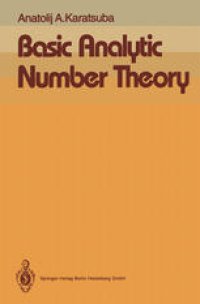
Ebook: Basic Analytic Number Theory
- Tags: Number Theory
- Year: 1993
- Publisher: Springer-Verlag Berlin Heidelberg
- Edition: 1
- Language: English
- pdf
This English translation of Karatsuba's Basic Analytic Number Theory follows closely the second Russian edition, published in Moscow in 1983. For the English edition, the author has considerably rewritten Chapter I, and has corrected various typographical and other minor errors throughout the the text. August, 1991 Melvyn B. Nathanson Introduction to the English Edition It gives me great pleasure that Springer-Verlag is publishing an English trans lation of my book. In the Soviet Union, the primary purpose of this monograph was to introduce mathematicians to the basic results and methods of analytic number theory, but the book has also been increasingly used as a textbook by graduate students in many different fields of mathematics. I hope that the English edition will be used in the same ways. I express my deep gratitude to Professor Melvyn B. Nathanson for his excellent translation and for much assistance in correcting errors in the original text. A.A. Karatsuba Introduction to the Second Russian Edition Number theory is the study of the properties of the integers. Analytic number theory is that part of number theory in which, besides purely number theoretic arguments, the methods of mathematical analysis play an essential role.
This book provides an introduction to four central problems in analytic number theory. These are (1) the problem of estimating the number of integerpoints in planar domains (2) the problem of the distribution of prime numbers in the sequence of all natural numbers and in arithmetic progressions (3) Goldbach's problem on sums of primes, and (4) Waring's problem on sums of k-th powers. To solve these problems, one uses the fundamental methods of analytic number theory: complex integration, I.M.Vinogradov's method of trigonometric sums, and the circle method of G.H.Hardy, J.E.Littlewood, and S.Ramanujan. There are numerous exercises at the end of each chapter. These exercises either refine the theorems proved in the text, or lead to new ideas in number theory. The author also includes a section of hints for the solution of the exercises. The mathematical prerequisites for this volume are undergraduate courses in number theroy, mathematical analysis, and complex variables. The book would be an excellent text for a one or two semester course in analytic number theory for advanced undergraduates or graduate students.
This book provides an introduction to four central problems in analytic number theory. These are (1) the problem of estimating the number of integerpoints in planar domains (2) the problem of the distribution of prime numbers in the sequence of all natural numbers and in arithmetic progressions (3) Goldbach's problem on sums of primes, and (4) Waring's problem on sums of k-th powers. To solve these problems, one uses the fundamental methods of analytic number theory: complex integration, I.M.Vinogradov's method of trigonometric sums, and the circle method of G.H.Hardy, J.E.Littlewood, and S.Ramanujan. There are numerous exercises at the end of each chapter. These exercises either refine the theorems proved in the text, or lead to new ideas in number theory. The author also includes a section of hints for the solution of the exercises. The mathematical prerequisites for this volume are undergraduate courses in number theroy, mathematical analysis, and complex variables. The book would be an excellent text for a one or two semester course in analytic number theory for advanced undergraduates or graduate students.
Content:
Front Matter....Pages i-xiii
Integer Points....Pages 1-26
Entire Functions of Finite Order....Pages 27-40
The Euler Gamma Function....Pages 41-50
The Riemann Zeta Function....Pages 51-63
The Connection Between the Sum of the Coefficients of a Dirichlet Series and the Function Defined by this Series....Pages 64-72
The Method of I.M. Vinogradov in the Theory of the Zeta Function....Pages 73-93
The Density of the Zeros of the Zeta Function and the Problem of the Distribution of Prime Numbers in Short Intervals....Pages 94-101
Dirichlet L-Functions....Pages 102-121
Prime Numbers in Arithmetic Progressions....Pages 122-140
The Goldbach Conjecture....Pages 141-159
Waring’s Problem....Pages 160-180
Back Matter....Pages 181-222
This book provides an introduction to four central problems in analytic number theory. These are (1) the problem of estimating the number of integerpoints in planar domains (2) the problem of the distribution of prime numbers in the sequence of all natural numbers and in arithmetic progressions (3) Goldbach's problem on sums of primes, and (4) Waring's problem on sums of k-th powers. To solve these problems, one uses the fundamental methods of analytic number theory: complex integration, I.M.Vinogradov's method of trigonometric sums, and the circle method of G.H.Hardy, J.E.Littlewood, and S.Ramanujan. There are numerous exercises at the end of each chapter. These exercises either refine the theorems proved in the text, or lead to new ideas in number theory. The author also includes a section of hints for the solution of the exercises. The mathematical prerequisites for this volume are undergraduate courses in number theroy, mathematical analysis, and complex variables. The book would be an excellent text for a one or two semester course in analytic number theory for advanced undergraduates or graduate students.
Content:
Front Matter....Pages i-xiii
Integer Points....Pages 1-26
Entire Functions of Finite Order....Pages 27-40
The Euler Gamma Function....Pages 41-50
The Riemann Zeta Function....Pages 51-63
The Connection Between the Sum of the Coefficients of a Dirichlet Series and the Function Defined by this Series....Pages 64-72
The Method of I.M. Vinogradov in the Theory of the Zeta Function....Pages 73-93
The Density of the Zeros of the Zeta Function and the Problem of the Distribution of Prime Numbers in Short Intervals....Pages 94-101
Dirichlet L-Functions....Pages 102-121
Prime Numbers in Arithmetic Progressions....Pages 122-140
The Goldbach Conjecture....Pages 141-159
Waring’s Problem....Pages 160-180
Back Matter....Pages 181-222
....